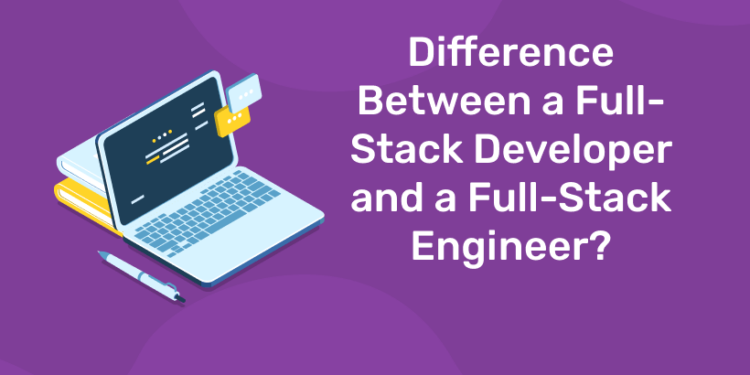Table of Contents
Those working in or looking to pursue a career in the computer science industry may find it beneficial to understand the differences between full stack developers and software engineers. Though these roles share some similarities, they often differ in their level of specialization, the aspects of projects they work on and the amount of leadership they experience for a project. In this article, we identify the differences between full stack developers and full-stack engineers, including their job descriptions, duties, skills and their level of program accessibility.
What is a full stack developer?
A full stack developer manages the front-end of a website, which includes the parts that are visible, as well as the back-end, which includes the infrastructure running the website, development of a website or application. They design and code websites and applications, interact with clients and work on databases, application programming interfaces (APIs) and servers.
Full stack developers often know how to work with multiple coding languages, such as HTML, CSS and JavaScript. They can also work with front-end frameworks such as React, Vue and Angular. They often oversee projects, and they are effective in both client consultation and server development and design. Depending on the project, full stack developers may also work on mobile, web or native application stacks.
Grab the opportunity to learn Full Stack Development with Entri! Click Here
What is a full-stack engineer?
1: Which of the following is a JavaScript framework/library?
A full-stack engineer is a high-level software engineer that works to design, test, and implement various software applications. They create software, applications, and scalable web services, while also providing leadership for coding teams. Full-stack engineers usually possess enormous skills and are involved in each stage of software development. This can include data structure completion, architecture design, code review, performance evaluation, internal tool management, and updates. The term “full-stack” refers to the engineer’s ability to work on both the front-end and back-end development of an application.
🚀 Start Coding Today! Enroll Now with Easy EMI Options. 💳✨
Get Hired as a Full-Stack Developer: Master the Skills Employers Are Looking For!
Start Learning With EMI Payment OptionsWhat does a full-stack engineer do?
At the beginning of a project, full-stack engineers may meet with members of the software development team in order to lay out the scale and scope of the software project. After that, they will begin designing and building the software. Full-stack engineers write various high-level and low-level code. They troubleshoot errors, help design the user experience (UX), resolve bugs, and improve the overall efficiency of the software. Full-stack engineers need excellent collaboration skills because they work with front- and back-end development team members.
Full-stack engineer tools and skills
Full-stack engineers are master coders. They are typically familiar with the following popular programming languages:
- Python
- JavaScript
- C
- Node
- HTML/CSS
- SQL
- PHP [1]
Full stack developer vs. Full stack engineer work duties
The work duties of full stack developers and full stack engineers sometimes overlap, and the distinctions between these roles may vary by project or industry. For example, there may be more definitive distinctions between full stack engineers and full stack developers working on a major project with a large team. Smaller projects that have fewer team members might combine the two positions’ common duties.
Full stack developers and full stack engineers both work to achieve project goals and meet client objectives. However, full stack developers often hold leadership roles, while full stack engineers may work under the supervision of full stack developers and use their expertise to develop specific project features. Although these professionals often work as part of a team, many full stack developers and engineers work as freelancers or contractors.
Here is a list of some tasks full stack developers perform:
-
Consulting with clients
-
Developing software prototypes
-
Designing applications
-
Leading product development teams
-
Writing code for back-end operations
-
Writing and optimizing code for front-end operations
-
Testing code to meet clients’ expectations
-
Monitoring performance of web architectures
-
Troubleshooting and resolving issues with web applications
Here is a list of some tasks full stack engineers perform:
-
Developing and directing software system testing
-
Managing software development cycles
-
Communicating project details with clients and team members
-
Applying engineering and mathematic principles to software development
-
Monitoring system performance
-
Developing project plans and proposals
-
Analyzing data to improve existing systems
-
Working alongside team members
-
Designing and implementing systems
🚀 Start Coding Today! Enroll Now with Easy EMI Options. 💳✨
Get Hired as a Full-Stack Developer: Master the Skills Employers Are Looking For!
Start Learning With EMI Payment OptionsFull stack developer vs. full stack engineer skills
Full stack developers and full stack engineers typically require distinct skill sets to excel in their jobs. Both jobs require specialized technical skills and well-developed soft skills to succeed. Full stack developers may require additional project management skills compared to full stack engineers.
“Experience the power of our web development course with a free demo – enroll now!”
Here are some of the key skills that can help full stack developers and full stack engineers perform their tasks effectively:
Full stack developer skills
Here are some skills full stack developers often use:
Technical skills
Full stack developers often possess knowledge of several coding and programming languages to succeed in their roles. Essential front-end languages that full stack developers typically know include HTML, CSS and JavaScript. Successful full stack developers also usually know some languages used in back-end development, such as PHP, Python, Ruby and Java. They require a comprehensive understanding of web architecture and the ability to structure code, categorize files, structure data in databases and perform necessary computations.
Project management skills
Full stack developers often hold leadership roles for application development projects. They may use project management skills to oversee projects—from the initial planning and consultation stages to a project’s execution and completion. Project management skills include the ability to manage tasks and a project’s budget. Other project management necessities include knowing how to properly lead a team, communicating with clients and resolving problems.
Soft skills
Along with proper leadership, communication and interpersonal abilities, full stack developers often possess additional soft skills, including time management and attention to detail. They often prioritize tasks and work to meet client deadlines. Working with code also requires careful attention to detail. Successful full stack developers often employ creative thinking skills for designing visually appealing user interfaces. They are typically analytical thinkers with the ability to solve technical problems.
Full stack engineer skills
Here are the skills full stack engineers often use:
Technical skills
Similar to full stack developers, full stack engineers are often familiar with several coding languages. Most have experienced knowledge in at least two languages but may also have a basic knowledge of all relevant coding languages. Some coding languages that software engineers know include C++, Java, C#, Python and Ruby. They also usually understand computer and database architecture, data structures and optimization strategies.
Design skills
Effective full stack engineers develop skills in visual design and web design. They have a thorough knowledge of proper web design principles, such as content, usability, aesthetics, visibility and interaction. Full stack engineers may work directly with clients to develop application designs that meet their needs.
Soft skills
Full stack engineers often work both independently and as part of a team. Their roles require skills such as time management and organization to meet strict deadlines. Essential skills for full stack engineers include effective attention to detail and the ability to think analytically when solving programming problems. Full stack engineers also use communication, collaboration and interpersonal skills to work with other team members.
Full stack developer vs. Full stack engineer program accessibility
Full stack developers and full stack engineers may have different levels of access to program resources for a project. Here are the differences in the level of program accessibility for full stack developers and full stack engineers:
Full stack developer program accessibility
Since full stack developers oversee most, if not all, parts of a project, they often have access to all program resources. Having full access to every aspect of a project allows full stack developers to assist team members when solving problems. This access may reduce time spent troubleshooting from those who don’t have the same access.
Full stack engineer program accessibility
Full stack engineers often don’t possess full access to all of a program’s resources. They typically only require access to programs that apply to their particular stage in the software development cycle. However, when working with team members, full stack engineers may gain access to relevant program resources.
Is there any difference between a full-stack engineer and a full-stack developer?
Well, yes and no. In most cases, it is a 2-different name for the same position. However, to recognize their effort, the in-depth knowledge and the greater responsibilities of a developer, people call them “engineers”.
Undoubtedly, more than a full-stack developer, an engineer must know all about the architecture and design, they always looking at a “bigger picture” They may also act as a Project Manager or DevOps when needed. These things make full-stack engineers become a hard position to reach. As a result, people always find them very prestigious – a reference for every situation. Controversial, a full-stack developer is just someone who can code both backend and front end.
“A developer focus their talents often on a single area, a specific task, or within a specific environment, without looking at the “bigger picture”.
They do not care much about the architecture or database system which we sometimes call a “ code monkey”.
But somehow we must admit that the title is not a problem. You can change your title from developer to engineer without any complaint from other people as long as you deserve it. People just care about what can you do with your knowledge and experience. If you consider yourself as a full-stack engineer then show them your skill. Do not let them down – let them beyond their expectations.
What is the difference between full-stack engineers and other software engineers?
Distinguishing and understanding clearly the differences will help you find the right development team for your project.
Let’s look at the below table:
| Front-end | Back-end | Full-stack | |
| Responsible for | Client-side | Sever-side | Both + other tasks to make the software complete |
| Programming Language | HTML/ CSS/ Javascript | A Server-side language: Python, PHP, C, Java, Golang… | Both |
| Goal | The website is accessible to all users, and it remains responsive in all views – mobile and desktop. | Make sure that the website opens up and is functioning properly. | To complete a whole application with full back-end and front-end and all functions customers may need. |
| Qualities | Visual aesthetic
Up-to-date knowledgeUX/UI sensibility |
Time management
IndependentDetail – orientationLogical thinking |
Analytical mind
PatienceLove for learning attention to detail Creative vision discipline |
Front-end and back-end development are the key components that maintain optimal system function in applications and websites. While full-stack is responsible for both client-side and server-side, front-end or back-end developer is in charge of a specific area. They obviously have absorbed an intensive knowledge of their expert.












